- Home
- Cassandra Clare
The Shadowhunters Codex Page 19
The Shadowhunters Codex Read online
Page 19
Page 19
• Every six years a representative of the Clave is sent to ask those children of ex-Shadowhunters if the children would like to leave their family and be raised among Shadowhunters in an Institute, as if they were orphans. Only when the child has turned eighteen does this practice end. (Those who reject the Nephilim into adulthood are not treated with the stigma of ex-Shadowhunters but have the same rights of protection as any mundane. The Clave has no wish to punish children for the crimes of their parents. )
• A Shadowhunter who has been turned into a Downworlder can no longer be Nephilim but should not be punished in the manner of those who chose to leave. In these cases the person gives up the protection owed him by the Clave for being a Shadowhunter but becomes newly entitled to the protection granted to Downworlders.
DEATH
Most Shadowhunters die as Shadowhunters. And most die in battle with demons. Major buzzkill, Codex.
We Nephilim burn our dead, discarding the fragile physical body that has trapped us and restricted us for our short human lives. Our remains are then interred. Those who die in Idris are traditionally entombed in its necropolis, outside Alicante’s walls. Those who die outside Idris are entombed in the Silent City. The Silent Brothers have responsibility over the dead in both locations. Most Shadowhunter families are old families and as a result have not merely grave plots but large family tombs and mausoleums, often one in each of the two necropolises.
Before being set on the funeral pyre, the Shadowhunter’s body is presented so that words of mourning can be spoken and those left behind can pay their last respects. Those in mourning traditionally wear white, and Mark themselves in red. The eyes of the dead Shadowhunter are bound with white silk, and he is laid to rest with his arms crossed over his chest, a seraph blade clutched in the right hand and resting over his heart. Funeral rites vary depending on the part of the world the Shadowhunter is from but traditionally conclude with a sentence from The Odes of Horace: Pulvis et umbra sumus. “We are dust and shadows. ”
Hoo boy, I can’t read this right now. No no no. Too much.
Yeah, for me too. We’ve had a little too much dust and shadows lately.
SILENT BROTHERS AND IRON SISTERS
THE SILENT BROTHERS
Our Unnerving Allies
And Jonathan took his stele, the first stele, and slowly he drew a V, then another, then another, in a continuous line, VVVVV, from David’s upper lip to his bottom lip and back again. The stele was warm in his hand and left a fine indentation of crosshatch that remained even after the stele’s point was withdrawn.
Jonathan drew back, finished, and cocked his head at David, not sure if the Mark had taken.
David began to open his mouth to speak, and as he did, the lines on his mouth burned gold, and his lips caught just slightly open, held together by black threads, thin but strong. Jonathan stepped back and lifted the stele without thought, unsure. But the corners of David’s mouth turned up slightly in what he was now able to produce in lieu of a smile.
“Sir?” Jonathan said, his voice wavering.
It is good, Shadowhunter, David said abruptly in Jonathan’s mind. His voice was strong and calm and echoed in Jonathan’s head much more loudly than Jonathan would have expected. Now, David went on, lifting two fingers to his own face like a gesture of blessing. Now the eyes.
—From Jonathan and David in Idris, by Arnold Featherstone, 1970
The Silent Brothers are indeed our brothers—brothers to all Nephilim. Do not be frightened of them. Their appearance may be disconcerting, or even sickening, to you on first glance, but they are Nephilim, like you, and you fight on the same side, toward the same goals. (Most Shadowhunters get over their fear of Silent Brothers the first time they are injured in battle and the Brothers nurse them back to health. ) It is worth noting that many Silent Brothers enjoy unsettling their fellow Nephilim, and deliberately play up their spookier features. This is a kind of hazing and should be taken as the good fun it is intended to be.
No sudden moves, though.
It is easy for new Nephilim to look upon the Silent Brothers as somehow more holy or angelic or powerful than the rest of us, but this is not in fact the case. The Silent Brothers rarely fight and lack any of the many combat runes that you will likely receive to enhance your physical and mental abilities. Instead they have taken Marks upon themselves that grant them access to the more esoteric corners of the Gray Book. They are our doctors, our scholars, our archivists. To them is given jurisdiction over the Nephilim dead. This of course includes those who rest in the Silent City, but the cemetery of Idris, too, is the Silent Brothers’ domain.
The Marks that the Silent Brothers use in their work are not so much forbidden to other Nephilim as hidden from our sight. In essence, parts of the Gray Book are locked and invisible to us, and the Marks the Brothers are inscribed with are the key. The Silent Brothers therefore have access to strange magic that you will not see performed by other Nephilim. In exchange for their special abilities, they have given up some of their humanity, moving farther from the Earth and closer to Heaven than the rest of us. They are still human, but their extraordinary nature makes them often disconcerting to us: They leave no footprints, do not cast shadows, do not move their mouths to speak, and do not sleep. Their bodies are tugged upward by Heaven, just as vampires’ bodies are tugged downward by Hell.
Befitting their seraphic alliance, the Silent Brothers are sometimes called the Grigori. The term refers to the Watchers, one of the higher orders of angels (the Watchers are the angels who are present in the trial of Nebuchadnezzar in the Hebrew Bible, for example), and is applied to the Silent Brothers not to claim their status as more heavenly than other Nephilim, but rather as a reference to their role among the Shadowhunters: watchers rather than fighters. The term has gone out of fashion and is considered archaic but can be found in many older Nephilim writings.
The official habit of the Silent Brothers is a parchment-colored, hooded robe, belted at the waist. Novice Silent Brothers will usually have plain robes, while those who have advanced to full Brotherhood will have decorative Marks circling the cuffs and hems of their robes, in bloodred ink. High-ranking Brothers are sometimes known to carry scepters; these scepters are usually pure silver and are also decorated with Marks, with the head carved in a figurative symbolic shape, such as an angel with outstretched wings, a chalice, or the hilt of a sword. Silent Brothers cast no shadows on the rare occasions they are found in the sun; this is widely believed to be an affectation, like the robe, rather than having some actual purpose.
The Silent Brothers must, by Law, have both their eyes and mouths shut with Marks. There are several different Marks that accomplish this, and the different processes vary, from magically stitching the eyes and mouth shut; to merely keeping the eyes and mouth permanently closed with the Mark of Fettering; to cleanly removing the eyes and/or mouth entirely, leaving blank spaces of flesh where they once were. The latter is, obviously, the most permanent and irreversible of these and is considered the most devout means of Marking oneself as a Silent Brother.
THE IRON SISTERS
The Iron Sisters are a monastic order, like the Silent Brothers, the members of which have taken Marks upon themselves for a specific purpose that requires them to become more than merely human. In the case of the Sisters, however, they have taken upon themselves the ability to work the angelic stone adamas, and craft it and whatever other mundane materials are needed into the arms, armor, and tools that keep the Nephilim alive and protected. The Sisters are the only Nephilim permitted to handle adamas pur, unworked adamas.
Like the Brothers, the Iron Sisters must join the order by taking Marks upon themselves that act as keys to unlocking normally hidden sections of the Gray Book. These Marks also serve to distance them from the rest of humanity. (The Marks are different between the two orders, and being Marked as a Silent Brother does not give you access to the Iron Sisters’ Marks, nor vice versa. ) Al
so like the Silent Brothers, the Iron Sisters are not fighters, do not marry, and do not normally attend Council meetings or venture outside of their usual domain.
Iron Sisters are rarely encountered by most Nephilim, but when they are, they are significantly less unsettling in appearance than the Silent Brothers. Their eyes and mouths are not magically closed, and they can neither read minds nor speak telepathically. They wear simple clothes, long white gowns bound tightly at the wrists and waist by demon-wire, to protect their clothes from the holy fires in which their materials are worked. Apart from an appearance of agelessness, their only odd physical feature is their eyes, which typically glow with the colors of flames. It is said that the fires of their great forges burn behind their eyes.
Despite their somewhat more familiar mien, the Iron Sisters are even more private and removed from Nephilim society than the Silent Brothers. They live in solitude in their great Adamant Citadel—whose location on the Earth is unknown to any other Nephilim—and rarely venture outside their fortress. They do not like to be bothered and prefer to work in isolation. A Shadowhunter may live many years without seeing even one Iron Sister in the flesh.
The first Iron Sister, Abigail Shadowhunter, was concerned that despite the gender neutrality of the Shadowhunters, the Sisters would need to be protected from unwanted interference from male Shadowhunters, and so the Adamant Citadel was built to be, and has always been, open only to female Shadowhunters. Indeed, only women are permitted to speak to Iron Sisters.
DISCUSSION QUESTIONS AND THINGS TO TRY
1. Why do you think the Nephilim live under such a strict code of Law? How does it benefit our overall mission?
Sheer unbridled cussedness. Being the baddest hombres in town.
I wouldn’t have put it that way, but that’s pretty much the answer the Codex is looking for.
Law and order good! Chaos and anarchy bad!
Chaos and anarchy also part of our tools, but the Codex doesn’t like to admit it.
2. Have you been Marked? Describe the experience here. Did you have a bad reaction to it? Did you notice it working immediately? How have any Marks since the first Mark felt different?
The Codex actually sounds kind of creepy here. “Yeeeees, tell me eeeeeverything. ” I was Marked by a very cute boy with terrible impulse control. I don’t remember because I was basically unconscious but everyone was mad at him when I woke up. The end, love Clary.
Oh my God, your love is so epic.
IDRIS,
THE NEPHILIM HOMELAND
Idris is our country, our land of sanctuary and safety. If you, soon-to-be Shadowhunter, have not yet traveled there, you will likely do so in order to drink from the Cup and receive your first Marks, and there you will see the beauty and tranquility that have made it the best-loved of all Shadowhunter places. Angelic enchantment appears in each leaf, each river stone, each dwelling. The land stands presided over by the soaring fingers of adamas that form the towers protecting its capital, Alicante. These towers surround us with angelic light and shield the city and its people from demonkind. Usually.
WHERE IS IDRIS? WHAT IS IT LIKE?
The country of Idris is small, barely visible on a map of Europe. It is in fact little more than the city of Alicante, the plains that gently unroll beneath its walls, and the surrounding mountain range that protects it. Alicante is the only city—indeed, the only major settled area—in the country. This makes much of Idris difficult to traverse, even for Shadowhunters; its mountains are impassible except in high summer, due to heavy snows, and its woods, especially Brocelind Forest, are dense and unmarked by trails. Idris is, nonetheless, very beautiful country: low Alpine, stacked with sheaves of pine trees, among which meander countless rivulets and brooks. Though the land is different from any of its mundane neighbors—Germany, France, Switzerland—it evokes the same beauty as the landscapes of those countries.
Idris was not, as is commonly believed, made from land “stolen” from its bordering countries. Instead Raziel created an entirely new country, like blowing a bubble, in the middle of Europe. It is land made for no purpose other than to be a home for the Nephilim.
HOW TO GET TO IDRIS
Practice, practice, practice.
In order to reach Idris by air, one must fly to one of the airports in a neighboring country and travel overland across its border. Those who are used to the delights of mundane transportation technology may find this somewhat retrogressive, but we invite you to think of it instead as charmingly quaint. Of course, until the beginning of the twentieth century, the only means of reaching Idris at all was overland travel. The travel problem caused by Idris’s landlocked status was eventually solved by the invention of the Portal, now the most common means of getting there and back.
THE WARDS OF IDRIS
Come visit the wards! You can’t see them!
The wards around Idris are unique, and have proved impossible to comprehend or duplicate despite all our years of study. Humans are able to create wards that divert certain individuals away from a place or an object; they do this sometimes by illusion and sometimes by distraction. This is true of both Gray Book Marks and warlock magic. If a mundane passes through the Idris wards, however, he will be transported instantly to the corresponding location on the opposite border. This happens without any side effects or signs, so a mundane will have no awareness that he has passed instantly through an entire country. From the perspective of mundanes, it is as if Europe exists with no Idris in it at all, and indeed, this is how mundane maps depict things.
The wards of Idris were created by Raziel himself, as part of the initial set of gifts that he presented to Jonathan Shadowhunter. Their magic was not, apparently, magic that Raziel decided to share with his creations the Nephilim, and so we are unable to duplicate elsewhere, or at all modify, the wards of the Idris borders. Over the years Nephilim have argued endlessly about why the Idris wards allow the free passage of Downworlders and even demons themselves into Idris. In other words the wards prevent the discovery of Idris by the mundane world, but all members of the Shadow World may pass in and out freely. Many Shadowhunters have argued that Raziel’s purpose in warding Idris was to prevent the Nephilim from ever becoming involved in land conflicts with its neighbors. Idris is meant as a hidden sanctuary from the mundane, and as a home, not as a political entity among the nations of the world, and as such, its borders can never be altered.

 The Midnight Heir
The Midnight Heir Son of the Dawn
Son of the Dawn Angels Twice Descending
Angels Twice Descending City of Bones
City of Bones Vampires, Scones, and Edmund Herondale
Vampires, Scones, and Edmund Herondale Bitter of Tongue
Bitter of Tongue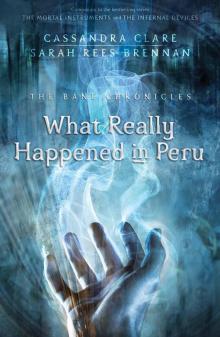 What Really Happened in Peru
What Really Happened in Peru Shadowhunters and Downworlders
Shadowhunters and Downworlders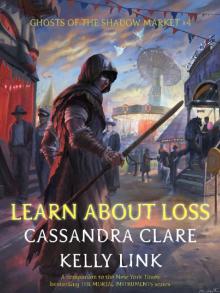 Learn About Loss
Learn About Loss What to Buy the Shadowhunter Who Has Everything
What to Buy the Shadowhunter Who Has Everything Welcome to Shadowhunter Academy
Welcome to Shadowhunter Academy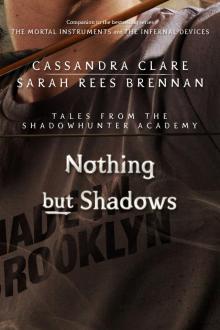 Nothing but Shadows
Nothing but Shadows Clockwork Prince
Clockwork Prince The Fiery Trial
The Fiery Trial City of Glass
City of Glass Clockwork Angel
Clockwork Angel City of Heavenly Fire
City of Heavenly Fire The Rise of the Hotel Dumort
The Rise of the Hotel Dumort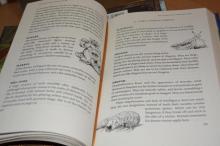 The Shadowhunters Codex
The Shadowhunters Codex Cast Long Shadows
Cast Long Shadows City of Lost Souls
City of Lost Souls Lady Midnight
Lady Midnight Lord of Shadows
Lord of Shadows The Whitechapel Fiend
The Whitechapel Fiend City of Fallen Angels
City of Fallen Angels Clockwork Princess
Clockwork Princess Queen of Air and Darkness
Queen of Air and Darkness Saving Raphael Santiago
Saving Raphael Santiago The Red Scrolls of Magic
The Red Scrolls of Magic City of Ashes
City of Ashes Pale Kings and Princes
Pale Kings and Princes The Runaway Queen
The Runaway Queen The Last Stand of the New York Institute
The Last Stand of the New York Institute A Long Conversation (The Shadowhunter Chronicles)
A Long Conversation (The Shadowhunter Chronicles) The Lost Book of the White
The Lost Book of the White Chain of Gold
Chain of Gold The Fall of the Hotel Dumort
The Fall of the Hotel Dumort Born to Endless Night
Born to Endless Night The Lost Herondale
The Lost Herondale An Illustrated History of Notable Shadowhunters & Denizens of Downworld
An Illustrated History of Notable Shadowhunters & Denizens of Downworld Ghosts of the Shadow Market
Ghosts of the Shadow Market Through Blood, Through Fire
Through Blood, Through Fire Every Exquisite Thing
Every Exquisite Thing City of Fallen Angels mi-4
City of Fallen Angels mi-4 The Land I Lost (Ghosts of the Shadow Market Book 7)
The Land I Lost (Ghosts of the Shadow Market Book 7) Queen of Air and Darkness (The Dark Artifices #3)
Queen of Air and Darkness (The Dark Artifices #3) The Wicked Ones (Ghosts of the Shadow Market Book 6)
The Wicked Ones (Ghosts of the Shadow Market Book 6) The Wicked Ones
The Wicked Ones A Deeper Love
A Deeper Love City of Fallen Angels (4)
City of Fallen Angels (4)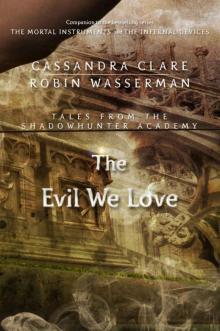 The Evil We Love (Tales from the Shadowhunter Academy Book 5)
The Evil We Love (Tales from the Shadowhunter Academy Book 5) Vampires, Scones, and Edmund Herondale tbc-3
Vampires, Scones, and Edmund Herondale tbc-3 City of Glass mi-3
City of Glass mi-3 Tales from the Shadowhunter Academy
Tales from the Shadowhunter Academy The Infernal Devices Series
The Infernal Devices Series City of Ashes mi-2
City of Ashes mi-2 Cassandra Clare: The Mortal Instruments Series
Cassandra Clare: The Mortal Instruments Series The Bane Chronicles 7: The Fall of the Hotel Dumort
The Bane Chronicles 7: The Fall of the Hotel Dumort The Last Stand of the New York Institute (The Bane Chronicles)
The Last Stand of the New York Institute (The Bane Chronicles) The Land I Lost
The Land I Lost![Saving Raphael Santiago - [Bane Chronicles 06] Read online](http://i1.bookreadfree.com/i1/04/03/saving_raphael_santiago_-_bane_chronicles_06_preview.jpg) Saving Raphael Santiago - [Bane Chronicles 06]
Saving Raphael Santiago - [Bane Chronicles 06] Clockwork Angel tid-1
Clockwork Angel tid-1 The Runaway Queen tbc-2
The Runaway Queen tbc-2 The Bane Chronicles
The Bane Chronicles City of Lost Souls mi-5
City of Lost Souls mi-5 Every Exquisite Thing (Ghosts of the Shadow Market Book 3)
Every Exquisite Thing (Ghosts of the Shadow Market Book 3) Shadowhunter’s Codex
Shadowhunter’s Codex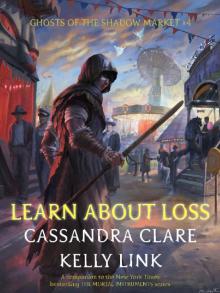 Learn About Loss (Ghosts of the Shadow Market Book 4)
Learn About Loss (Ghosts of the Shadow Market Book 4) Welcome to Shadowhunter Academy (Tales from the Shadowhunter Academy Book 1)
Welcome to Shadowhunter Academy (Tales from the Shadowhunter Academy Book 1) Saving Raphael Santiago tbc-6
Saving Raphael Santiago tbc-6 City of Bones mi-1
City of Bones mi-1 Ghosts of the Shadow Market Book 1_Son of the Dawn
Ghosts of the Shadow Market Book 1_Son of the Dawn Clockwork Princess (Infernal Devices, The)
Clockwork Princess (Infernal Devices, The) Clockwork Prince tid-2
Clockwork Prince tid-2 No Immortal Can Keep a Secret
No Immortal Can Keep a Secret A Deeper Love (Ghosts of the Shadow Market Book 5)
A Deeper Love (Ghosts of the Shadow Market Book 5) The Course of True Love (and First Dates)
The Course of True Love (and First Dates)